|
|
 |
|
Monstrilloida ( Order ) |
|
|
|
Monstrillidae ( Family ) |
|
|
|
Cymbasoma ( Genus ) |
|
|
| |
Cymbasoma sinopense Üstün, Terbiyik Kurt & Suarez-Morales, 2014 (F) | |
| | | | | | | Syn.: | Cymbasoma longispinosum : Dolgopolskayia, 1948 (p.178, figs.F) | | | | Ref.: | | | Üstūn, Terbiyik Kurt & Suarez-Morales, 2014 (p.1396, Descr.F, figs.F, Rem.) | 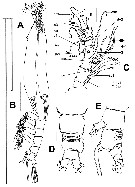 Issued from : F. Üstün, T. Terbiyik Kurt & E. Suarez-Morales in Crustaceana, 2014, 87 (11-12). [p.1397, Fig.2]. Female (from 42°00'53''N, 35°11'41''E): A, habitus (lateral view); B, ovigerous spine showing length with respect to body; C, A1 showing armature (following nomenclature by Grygier & Ohtsuka, 1995); D, urosome (dorsal view); E, same (lateral view) Scale bars: 500 µm (A, B); 100 µm (C-E). Nota: Urosome consisting of 5th pedigerous somite, genital double-somite, anal somite and caudal ramus, representing 14% of total body length; relative lengths of urosomites: 41.6 : 36.2 : 22.2 = 100. Ovigerous spines paired, extremely long, about 1.6 times total body length; one spine slightly shorter. Cephalothorax (incorporating 1st pedigerous somite) representing 66% of total body length. Oral papilla located at 18% of way back along ventral surface of cephalothorax. Pair of relatively large ocelli present, pigment cups moderately developed, medially conjointed, weakly pigmented; ventral cup and lateral cups equally sized.
|
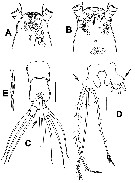 Issued from : F. Üstün, T. Terbiyik Kurt & E. Suarez-Morales in Crustaceana, 2014, 87 (11-12). [p.1398, Fig.3]. Female: A, Cephalic area showing forhead ornamentation (dorsal view); B, same, ventral view, showing cuticular processes and ornamentation, shell-like ventral process arrowed; C, genital double-somite and anal somite, ventral view, showing insertion of ovigerous spines and point of bifurcation of spines (arrowed); D, P5, ventral view showing globular processes on outer lobes (arrowed). Scale bears: 100 µm (A-C); 50 µm (D). Nota: P5 medially conjoined, bilobed, inne (endopodal) lobe rounded distally, well-developed, relatively large, reaching about halflength of outer (exopodal) lobe. Outer lobe with rounded protuberance on distal outer margin, at insertion of outermost seta (arrowed in fig.3D); lobe armed with 3 setae, one distal, two inserted subdistally. Outermost seta longest, biserially and lightly setulated; innermost seta shortest, this and medial seta with light setulation. Caudal ramus subrectangular, 1.3 times as long as wide, armed with 3 subequally long lightly setulated setae. Cephalic area with conspicuous area of deep, regularly and longitudinally arranged cuticular ridges on forehead between the A1 bases; sensillae not observed on cephalic area. Additional cephalic cuticular ornamentation including longitudinal shallow cuticular ridges overlying posterior surface of region of ocelli on dorsal surface; ridges only on right side and central surface, left side smooth. Ventral surface with shell-like cuticular process between A1 bases (arrowed in fig.3B) and 2 pairs of nipple-like processes on anterior ventral surface; anteriormost pair simple, without adjacent ridges or wrinkles, conical in shape; second pair well-developed, with conspicuous concentric reticulation (fig.3B). Other ventral cuticular ornamentation includes a small single process on anterior surface anterior to oral cone.
|
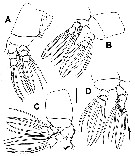 Issued from : F. Üstün, T. Terbiyik Kurt & E. Suarez-Morales in Crustaceana, 2014, 87 (11-12). [p.1399, Fig.4]. Female: A, P1; B, P2; C, P3 with longer basipodal seta (arrowed); D, P4 showing modified enlarged outer spine on 3rd exopodal segment (arrowed). Scale bars = 100 µm.
|
 Issued from : F. Üstün, T. Terbiyik Kurt & E. Suarez-Morales in Crustaceana, 2014, 87 (11-12). [p.1400]. Female: Armature formula of swimming legs P1 to P4.
|
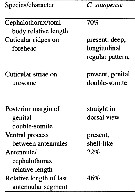 Issued from : F. Üstün, T. Terbiyik Kurt & E. Suarez-Morales in Crustaceana, 2014, 87 (11-12). [p.1403, Table I]. Taxonomic features and morphometry of females of Cymbasoma sinopense.
|
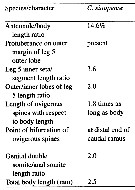 Issued from : F. Üstün, T. Terbiyik Kurt & E. Suarez-Morales in Crustaceana, 2014, 87 (11-12). [p.1404, Table I (continued)]. Taxonomic features and morphometry of females of Cymbasoma sinopense.
|
 Issued from : F. Üstün, T. Terbiyik Kurt & E. Suarez-Morales in Crustaceana, 2014, 87 (11-12). [p.1406, Table I I]. Comparison among illustrated records of Cymbasoma longispinosum (Bourne, 1890) from the Mediterranean (MED° (Giesbrecht, 1893 [1892]), the northern Black Sea (NBS) (Domgopolskaya, 1948) and from southern Black Sea (SBS) from Üstün & al., 2014. Nota: Based on this limited data set, and pending an examination of specimens, it is speculated that the Mediterranean C. longispinosum differs from those from the Black Sea in subtle characters including the absence of cuticular ridges on both the forehead area and the genital double-somite and in the shape (subtriangular, distally tapered) and size of the inner (endopodal) lobe of P5. Both forms of the Black Sea: Sevastopol Bay (Dolgopolskaya, 1948) and the Sinop Peninsula (Üstün & al., 2014) share several characters including the same kind of forehead ornamentation , striation present on the dorsal surface of the genital double-somite, the presence of a medial ventral protuberance near the antennule bases (details on its shape are unavailable from Dolgopolskaya, 1948), similar body proportions and last antennular segment, antennule/cephalothorax ratios, and a rounded inner lobe of P5. They differ in other details: (1) P5 of Sevastopol specimens appears to have a very small inner endopodal lobe, (2) the bifurcation of the ovigerous spines is probably beyond the distal end of the caudal rami (Dolgopolskayia, 1948, fig.9), although in other figures this bifurcation is located at the distal end of the caudal rami (figs.5, 6). Considering that the size of the inner lobes of P5 could also be inaccurately depicted, most of the characters suggest that the specimens reported from Sevastopol are assignable to the new species C.sinopense.
The divergence between the Mediterranean and Black Sea Cymbasoma longispinosum species supports the general patterns stated by Kovalev & al. (2001), indicating that these two basins have little exchange of zooplanktonic forms.
| | | | | NZ: | 1 | | |
|
Distribution map of Cymbasoma sinopense by geographical zones
|
| | | | | | | Loc: | | | Black Sea (Sinop Peninsula, Sebastopol Bay)
Type locality: 42°00'53'' N, 35°11'41'' E. | | | | N: | 1 +1 | | | | Lg.: | | | (1182)* F: 2,50; {F: 2,50}
*: body length measured from anterior end of head to the posterior margin of the anal somite. | | | | Rem.: | For Üstün & al. (2014, p.1402) this species is assigned to the genus Cymbasoma by virtue of the presence of 2 urosomal somites, with only 1 free somite located between the genital double-somite and the caudal rami. It is assignable to the Cymbasoma longispinosum species-group (See remarks in species C. lonsispinosum).
The new species from Turkish coast of the Black Sea most closely resembles C. morii, C. chemelense, C. californiense. | | | Last update : 19/07/2021 | |
|
|
 Any use of this site for a publication will be mentioned with the following reference : Any use of this site for a publication will be mentioned with the following reference :
Razouls C., Desreumaux N., Kouwenberg J. and de Bovée F., 2005-2025. - Biodiversity of Marine Planktonic Copepods (morphology, geographical distribution and biological data). Sorbonne University, CNRS. Available at http://copepodes.obs-banyuls.fr/en [Accessed December 04, 2025] © copyright 2005-2025 Sorbonne University, CNRS
|
|
 |
 |









